Part 2: The increasing role of financial assets in the public sector
2.1
In this Part, we highlight the use of financial assets in the public sector, compare the financial assets held by central and local government, and compare New Zealand with other countries.
Using financial assets effectively
2.2
Financial assets are not new to the public sector. For many years, cash, bank deposits, and accounts receivable (money owed to an entity but not yet received) have been used to manage the flow of cash through the entity. Also, targeted funds (cash deposits and shares) have been set aside to meet future liabilities. For example, the Earthquake and War Damage Commission (the original Earthquake Commission) was set up in 1945 with a fund of £4 million to cover earthquake risk.8
2.3
However, in the last couple of decades, the value and use of financial assets have increased significantly, particularly in central government. Today, financial assets are being used to fund or finance9 various public sector services. For example:
- The Earthquake Commission's considerable financial assets were used to help pay for claims associated with the Canterbury earthquakes.
- ACC uses financial assets to help pay the costs of providing accident cover to all New Zealanders.
- The financial assets of the New Zealand Superannuation Fund (NZSF) are designed to contribute to the country's superannuation costs in the future.
- The income from New Plymouth District Council's financial assets (held in its Perpetual Investment Fund) plays an important role in funding the local authority's services to ratepayers.
2.4
Figure 2 shows the different ways in which financial assets can help the delivery of public services.
Figure 2
Using financial assets to help deliver public services
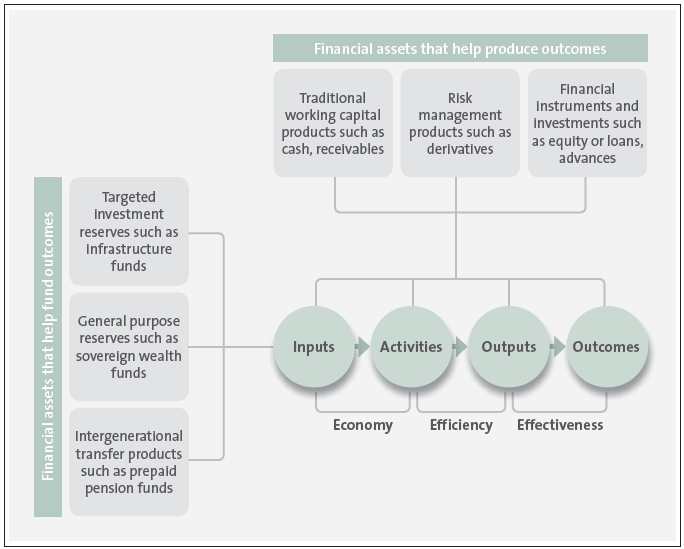
Source: Office of the Auditor-General.
Opportunities for public entities and the whole of government
2.5
For public entities, financial assets support traditional funding and delivery mechanisms. They are usually easier to buy, hold, and sell than physical assets, can be owned in small or divisible amounts, and have values that are more responsive to changing circumstances and market conditions. They can therefore introduce more liquidity and flexibility, which can be particularly important in times of change and uncertainty.
2.6
As the public sector's experience in using financial assets expands, the opportunities available to public entities and to the whole of government for funding and providing services will increase.
2.7
Public entities use financial assets in many ways.
Motivating entities or partners to act in certain ways
2.8
Crown Fibre Holdings Limited is using an innovative share-ownership transfer structure to co-invest with private sector partners to set up the ultra-fast broadband network throughout New Zealand.
Taking advantage of other ways of funding and delivering policy outcomes
2.9
New Zealand Venture Investment Fund Limited has venture capital and seed co-investment funds, and the Waitaki District Council is using loan funding to support a retirement village development in Oamaru.
Reallocating project or programme risks
2.10
Auckland Council reduces its exposure to changes in interest rates by various means, including using interest-rate derivatives. State-owned electricity generators also use derivatives to protect against the volatility in electricity prices.
Encouraging private sector providers to take part in public projects and programmes
2.11
Private sector equity providers enter into public-private partnerships through shareholdings in the contracting entity.
Promoting or influencing different investment or governance practices
2.12
ACC and the NZSF have signed up to the United Nations Principles for Responsible Investment. The NZSF is actively promoting, in New Zealand and abroad, long-term investment governance guidelines.
The sale of future revenue streams for use in other projects or to increase future debt capacity
2.13
In 2014, Hawke's Bay Regional Council repackaged 50 years of its future rental income from leasehold land it owns in Napier and sold the financial asset to ACC. In exchange, the Council received an upfront cash payment, which will be used to invest in infrastructure projects.
Other uses of financial assets
2.14
Financial assets are also being thought about and used at a whole-of-government level.
2.15
Financial assets are being used to provide independence in the management of assets while retaining a chosen level of control. For example, the Government's shareholding in Air New Zealand allowed it to progressively increase the company's commercial independence while retaining a meaningful ownership interest. Many local government entities hold strategic shareholdings in organisations that benefit a region's long-term prospects, such as airports or ports.
2.16
The Treasury is also considering the usefulness of a "stabilisation fund" to "act as a complement or alternative to using changes in debt as a buffer to manage volatility in revenues."10
The extent of financial assets in the public sector
2.17
The FSG and local government annual reports show that, in 2014, the public sector had total financial assets of about $132 billion. Figure 3 shows those public entities with the largest holdings of financial assets and how the value of those assets has changed since 2008.
Figure 3
Public entities with the largest financial assets by value

Source: Drawn from the Financial Statements of the Government and local government annual reports.
2.18
These 13 public entities hold about 87% of all public sector financial assets. The main increases since 2008 have been in New Zealand Post (mainly Kiwibank Limited's mortgage lending), ACC, and the NZSF. In 2008, Southern Response Earthquake Services Limited (Southern Response), the LGFA, and Auckland Council did not exist in their current form.
2.19
The financial assets of the Earthquake Commission and Southern Response have declined significantly since 2014, because they have been used to meet claims in support of Canterbury's recovery from the 2010 and 2011 earthquakes.11 These financial assets were an important contribution to the recovery in Canterbury.
2.20
At 30 June 2014, the total value of financial assets in central government entities was about $125 billion, including tertiary educational institutions' financial assets. For local government, the total value of financial assets in all entities in 2014 was about $7.1 billion.
2.21
Figure 4 shows the composition of financial assets in central government and how the composition has changed since 2008.
Figure 4
Composition of financial assets in central government
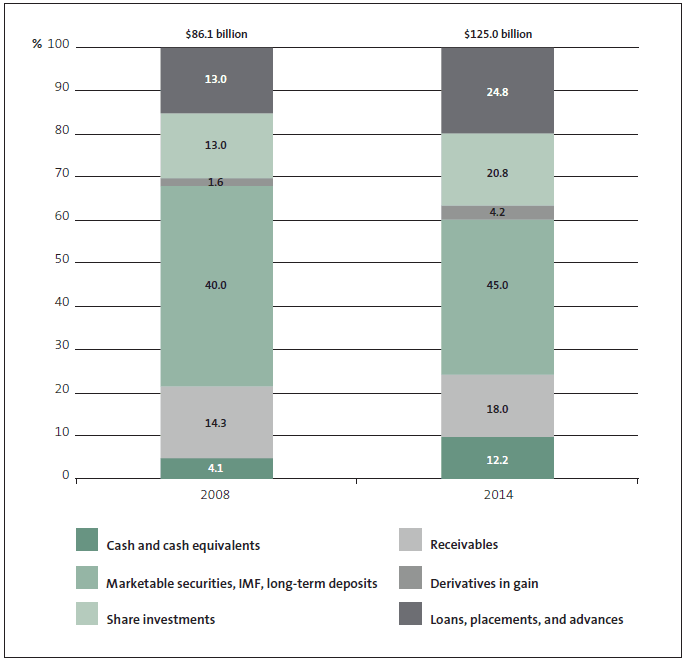
Source: Financial Statements of the Government, adjusted to incorporate the financial assets of tertiary education institutions.
2.22
In central government, the proportions of financial assets have moved slightly, with the small reduction in marketable securities offset by increases in the proportion of cash and derivatives. Marketable securities remain the dominant type of financial asset.
2.23
Figure 5 shows the composition of financial assets in local government and how the composition has changed since 2008.
Figure 5
Composition of financial assets in local government
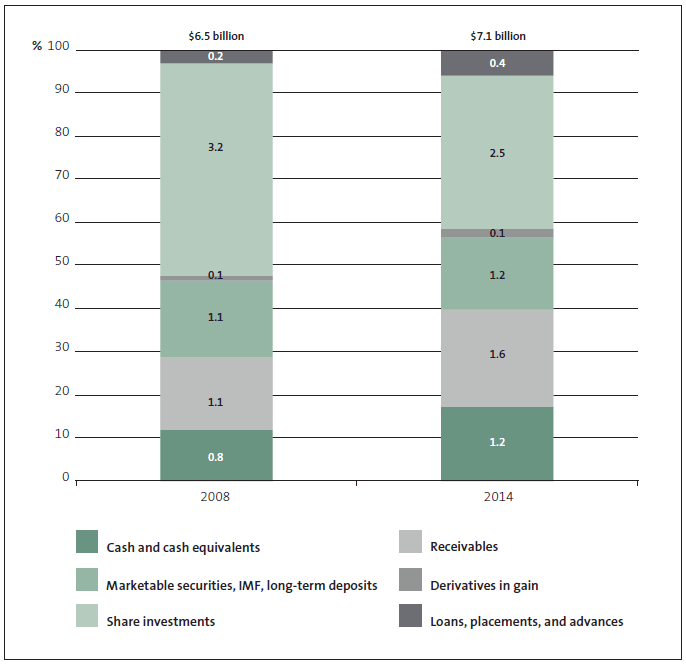
Source: Local government annual reports.
2.24
In local government, share investments have reduced in value but remain the dominant asset class. One reason for this reduction was the creation, in 2010, of Auckland Council, which took control of various large organisations that were then consolidated into Auckland Council's financial statements. For example, before the formation of Auckland Council, many of the previous local authorities held minority shareholdings in Watercare Services Limited, a large company with significant physical assets. These minority shareholdings were reported as financial assets (share investments). On amalgamation, Auckland Council took control of Watercare, and the company's underlying assets and liabilities were all reported as separate line items in Auckland Council's financial statements.
2.25
The value of in-gain derivatives in local government has increased from $70 million in 2008 to $143 million in 2014.12
2.26
Comparing the total value of financial assets to total liabilities shows that, for both sectors, financial assets are a material part of overall financial capacity. For central government, financial assets are about 70% of total liabilities and, for local government, financial assets are about 38% of total liabilities.
2.27
Although the proportions of central government financial assets have not changed significantly since 2008, the transaction activity in those financial assets has. Figure 6 shows the increase in annual transactions involving financial assets. To highlight their significance relative to the total activities of the Government, we also show total Crown revenue in 2008 and 2014.
Figure 6
Increase in central government transactions involving financial assets
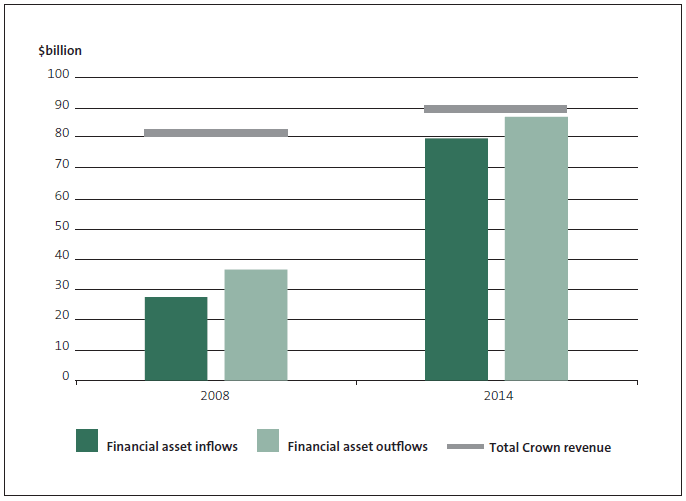
Source: Financial Statements of the Government.
2.28
Financial asset transactions in central government (incorporating both inflows and outflows) have increased at a faster rate than increases in the value of financial assets. In 2014, the value of these transactions was about the same as the total revenue of the Crown. One of the main reasons for these significant increases is the increase in, and trading of, the NZSF's and ACC's financial assets. For example, ACC's purchases of investments increased from $14.7 billion in 2008 to $47.6 billion in 2014. ACC's proceeds from the sale of investments increased by a similar amount over the same period.
2.29
The relative significance of annual financial asset transactions to local government entities is small, at only about 5%-6% of local government revenue in 2014. The value of these transactions is also considerably smaller than those of central government and fell in value from 2008 to 2014. One of the reasons for the decline was a large decrease in financial asset-related transactions between the previous individual local authorities after Auckland Council was formed in 2010.
What could the future look like?
2.30
The Treasury, in its 2013 long-term fiscal statement projections, modelled the projected growth in financial assets to 2060. These financial asset projections do not include tertiary educational institutions' individual financial assets. In Figure 7, we have summarised these projections in 10-year periods from 2020.13 For comparison, we have also included the projected value of all physical assets.
Figure 7
Forecast growth in financial assets across central government
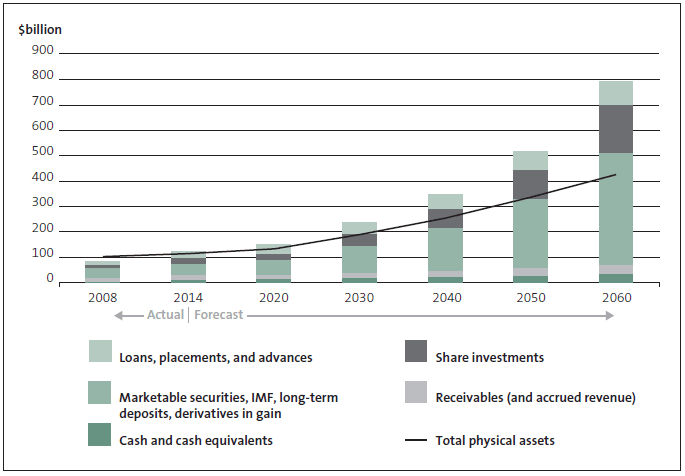
Source: Drawn from the Financial Statements of the Government and the Treasury's 2013 long-term fiscal model.
2.31
According to these projections, the bulk of the financial assets growth to 2060 is expected to be in marketable securities and shares. At 30 June 2014, about 48% of all government assets were financial assets. By 2060, this is projected to increase to 55%-65%, with the NZSF holding 30%-35% of those financial assets.14
2.32
Although significant variability in these central government projections is to be expected, the potential extent of the shift from physical to financial assets is clearly apparent.
2.33
Looking at the data from local authorities' 2015-25 long-term plans shows that local authorities expect cash, financial investments, and monetary assets to increase by just over 3% each year during the next 10 years.
How does New Zealand compare with other countries?
2.34
Figure 8 shows the value of central government financial assets compared with total liabilities in selected other countries – Australia, Canada, and the United Kingdom.
Figure 8
Public sector financial assets and total liabilities in New Zealand, Australia, Canada, and the United Kingdom
| 2008a | 2014 | |||||
|---|---|---|---|---|---|---|
| Financial assets | Total liabilities | Financial assets/Total liabilities | Financial assets | Total liabilities | Financial assets/Total liabilities | |
| New Zealand NZ$billion |
85 | 95 | 90% | 123 | 175 | 70% |
| Australia A$billion |
245 | 272 | 90% | 352 | 754 | 47% |
| Canada Can$billion |
176b | 692 | 25% | 318b | 1,001 | 32% |
| United Kingdom £billion |
421 | 2,419 | 17% | 516 | 3,189 | 16% |
Notes:
a. The figures for the United Kingdom are from 2010, when whole-of-government accounts were first published.
b. The assets of the Canadian Pension Plan fund are not consolidated into the financial statements of the Government of Canada.
Source: The Financial Statements of the Government and the financial statements of the governments of Canada, Australia, and the United Kingdom.
2.35
Points to note about the comparison include:
- Since 2008, the governments of New Zealand, Australia, and the United Kingdom have been less able to cover existing obligations by using their financial assets, possibly as a result of the global financial crisis reducing the value of financial assets and/or increasing total liabilities. Also, in the case of New Zealand, the financial assets held by the Earthquake Commission have been used to pay claims following the Canterbury earthquakes.
- New Zealand's and Australia's financial assets have grown by 45% and 44% respectively from 2008 to 2014. The largest increases were in (the usually less liquid) loans and advances (for example, student loans and Kiwibank mortgages).
- Of the four governments, New Zealand's continues to be relatively well placed to cover its liabilities.
The 2015 Financial Statements of the Government
2.36
The 2015 FSG support what we have said in this Part. For example, the 2015 FSG state that:
- The total value of financial assets in central government has increased further to $135.8 billion (excluding financial assets held by tertiary education institutions).
- The value of the Crown's financial sector assets (held in the Government Superannuation Fund, the New Zealand Debt Management Office, the Earthquake Commission, ACC, the Reserve Bank of New Zealand, and the NZSF) increased by about 17% during 2014/15.
- Marketable securities and share investments have increased more quickly than the other financial asset classes during the last year.
- Cash flows arising from financial asset transactions have increased further and are now well above (about 15%-20% higher) the total revenue of the Crown.
8: See the history section of the Earthquake Commission's website, www.eqc.govt.nz.
9: Funding and financing can sometimes have different meanings, particularly in local government. Funding can refer to the different sources of money available to pay for a project or service. Financing can refer to the arrangements put in place to ensure that money is available when it is needed.
10: See The Treasury's Budget 2014 Information Release, July 2014, pages 2-3.
11: See Southern Response Earthquake Services Limited's 2015 financial statements, page 8, and the 2015 Financial Statements of the Government, page 20.
12: Figures rounded to the nearest $1 million.
13: In its projections, the Treasury includes marketable securities and share investments together. For consistency, we have separated this group into marketable securities and share investments based on the 2014 proportions.
14: Based on the two future scenarios that the Treasury modelled in its 2013 long-term fiscal model.

